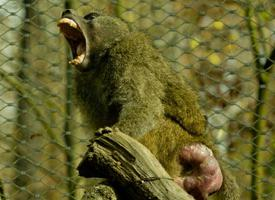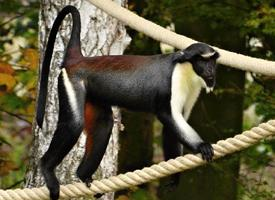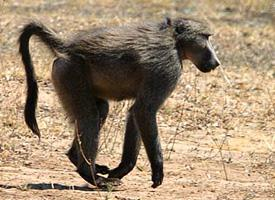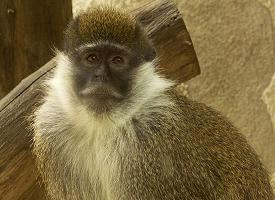
Váhy a míry
| Délka | od 60 do 70 cm |
|---|---|
| Hmotnost | od 15 do 24 kg |
| Délka ocasu | od 48 do 56 cm |
Biologická data
| Délka života | 20 r |
|---|---|
| Délka březosti | 180 d |
| Počet mláďat | 1 |
Popis zvířete
The Olive Baboon (Papio anubis), a prominent member of the Old World monkey family, stands out as a fascinating and adaptable primate species indigenous to 25 African countries. This species derives its common name from its coat color, which appears as a shade of olive-green due to the intermingling of yellow-brown and black hairs. Olive baboons are among the largest of the baboon family, with males significantly larger than females. Adult males can weigh between 24 to 45 kilograms (53 to 99 pounds), while females are generally smaller, ranging from 14 to 25 kilograms (31 to 55 pounds).Physically, the Olive baboon exhibits a robust and dog-like muzzle, a characteristic shared among baboons, which aids in their omnivorous feeding habits. Their powerful jaws and sharp canine teeth play a crucial role in their diet, which is as varied as their habitat. Olive baboons have a highly adaptable diet that includes fruits, leaves, insects, small mammals, and birds. This adaptability extends to their habitat preference, as they can thrive in various environments, from savannahs and forests to steppes and sub-desert areas, provided there is water access.
One of the most striking features of Olive baboons is their complex social structure. They live in troops that can number over a hundred individuals, consisting of a multi-level society where both males and females have their hierarchies. These hierarchies are maintained through social grooming, alliances, and sometimes aggression. Female baboons inherit their social rank from their mothers, while males leave their birth troops upon reaching maturity, around the age of eight, to join new groups, where they must establish their rank.
Communication among Olive baboons is sophisticated, encompassing a wide range of vocalizations, facial expressions, and body postures. These signals are crucial for maintaining social bonds, expressing emotions, and coordinating movements within the troop.
Reproduction in Olive baboons does not adhere to a strict seasonal pattern, although it may be influenced by food availability. Females give birth to a single offspring after a gestation period of approximately six months. Infant baboons are highly dependent on their mothers for the first few months, during which they enjoy considerable attention from the troop. This high level of social interaction plays a vital role in the development of the young baboons.
Olive baboons play significant roles in their ecosystems as seed dispersers and as prey for larger predators. However, they are often seen as pests by humans due to their tendency to raid crops and occasionally livestock, leading to conflicts.
Despite these conflicts and habitat destruction posing threats to their populations, Olive baboons are classified as Least Concern by the International Union for Conservation of Nature (IUCN), thanks to their wide distribution and adaptability. Nonetheless, their resilience should not lead to complacency, as they continue to face challenges from human expansion and environmental changes.
In summary, the Olive baboon is a remarkable primate with a complex social structure, adaptable feeding habits, and a wide range of communication methods. Its ability to thrive in diverse habitats underscores the importance of ongoing conservation efforts to ensure these fascinating animals continue to be a part of Africa's rich biodiversity.
Podobná zvířata
Nové fotografie zvířat
Top 10 zvířat
- Chinese water dragon (Physignathus cocincinus)
- Galápagos tortoise (Geochelone nigra complex)
- Dolphin gull (Leucophaeus scoresbii)
- Japanese macaque (Macaca fuscata)
- Colombian red howler (Alouatta seniculus)
- Sea urchins (Echinoidea)
- Moustached guenon (Cercopithecus cephus)
- Diana monkey (Cercopithecus diana)
- Common reed warbler (Acrocephalus scirpaceus)
- Common house mosquito (Culex pipiens)


